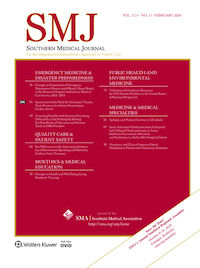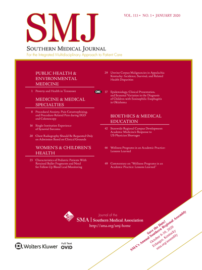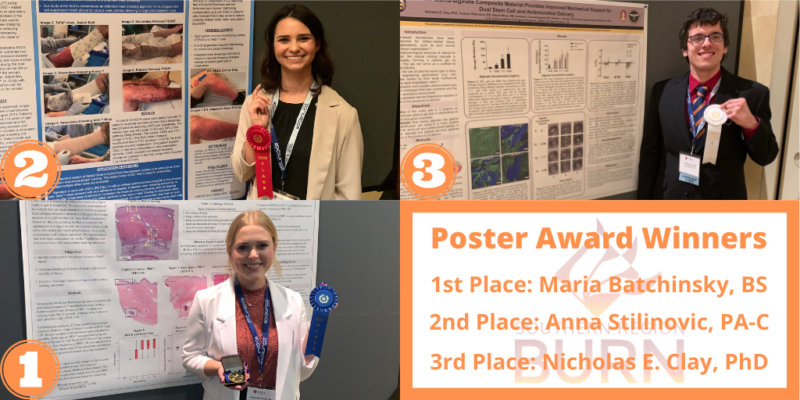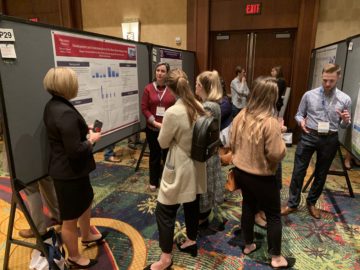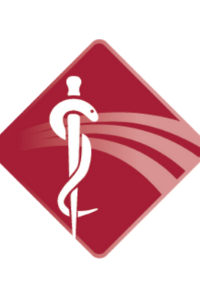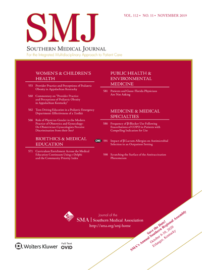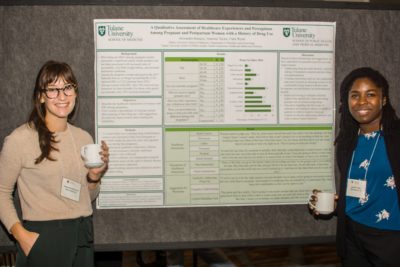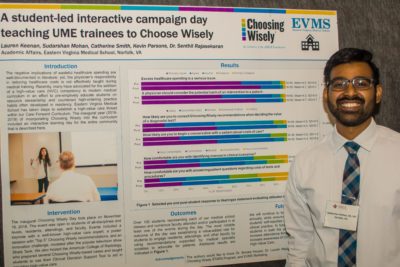
SMJ Online CME Courses
June 2019, VOL. 112, NO. 06
Workplace Violence: Experiences of Internal Medicine Trainees at an Academic Medical Center
Healthcare professionals are at higher risk for workplace violence (WPV) than workers in other sectors. This elevated risk exists despite the vast underreporting of WPV in the medical setting. The challenge of responding to this risk is compounded by limited empirical research on medical training environments. Understanding trainees’ experience and educating them on workplace safety, WPV reporting, and awareness of resources are shared goals of educational and institutional leadership.
July 2019, VOL. 112, NO. 07
Retrospective Analysis of the Effect of Postdischarge Telephone Calls by Hospitalists on Improvement of Patient Satisfaction and Readmission Rates
Healthcare professionals are at higher risk for workplace violence (WPV) than workers in other sectors. This elevated risk exists despite the vast underreporting of WPV in the medical setting. The challenge of responding to this risk is compounded by limited empirical research on medical training environments. Understanding trainees’ experience and educating them on workplace safety, WPV reporting, and awareness of resources are shared goals of educational and institutional leadership.
August 2019, VOL. 112, NO. 08
Moral Controversy and Working with Colleagues with a Shared Ethical/Moral Outlook: A National Survey of US Primary Care Physicians
Moral controversy in health care may pose a particular challenge for physicians with lower commitments to theological pluralism. In this national study of PCPs, physicians who identified as religious, spiritual, or having a high sense of calling were found to place a stronger emphasis on the importance of shared ethical/moral outlook with work colleagues regarding morally controversial healthcare practices.
September 2019, VOL. 112, NO. 09
Benefits of Using The Pause after Death in Emergency Departments: A Delphi Study
Emergency clinicians face an increased risk of burnout because of the nature of their profession. They are considered to be in the medical specialty at highest risk for burnout. Health systems across the United States are incorporating trainings in an effort to decrease the prevalence of burnout among emergency clinicians. It is suggested that education programs can be useful in ameliorating burnout if adapted to a unit’s culture. Healthcare organizations should provide resources to clinicians that provide a toolkit of methods to manage and process workplace stress.
October 2019, VOL. 112, NO. 10
A More Directive Living Will for Older Adult Patients with End-Stage Medical Conditions?
Many older adult patients want to be treated aggressively for reversible conditions, even when their current quality of life is limited; however, most standard living wills focus on the very end of life and provide little guidance to acute care providers (ACPs) should their older adult patient be admitted with a potentially treatable acute condition and temporarily lose capacity. The authors developed what they believe is a more informational and directive living will for this population, and sought to determine whether ACPs would find the pilot living will more helpful when caring for their older adult patients.
November 2019, VOL. 112, NO. 11
Impact of β-Lactam Allergies on Antimicrobial Selection in an Outpatient Setting
Many older adult patients want to be treated aggressively for reversible conditions, even when their current quality of life is limited; however, most standard living wills focus on the very end of life and provide little guidance to acute care providers (ACPs) should their older adult patient be admitted with a potentially treatable acute condition and temporarily lose capacity. The authors developed what they believe is a more informational and directive living will for this population, and sought to determine whether ACPs would find the pilot living will more helpful when caring for their older adult patients.
December 2019, VOL. 112, NO. 12
A Hospitalist-Led Team to Manage Patient Boarding in the Emergency Department: Impact on Hospital Length of Stay and Cost
Admitted patients boarding in the emergency department (ED) while awaiting inpatient beds represent a bottleneck in patient flow and is recognized as one of the primary causes of ED overcrowding. Studies have shown that hospitals operating at or near maximumcapacity have an increased ED length of stay (LOS), which is associated with multiple negative downstream consequences, including patient dissatisfaction, inappropriate utilization of resources, and decreased quality of care. Hospitalist-led management of admitted patients boarding in the ED has been identified as a potential solution to improve patient flow. The authors sought to examine the impact on patient flow and potential for cost savings by an active management of boarded ED medical admissions by a hospitalist-led team, which included a hospitalist, an advanced practitioner, and a case manager.
January 2020, VOL. 113, NO. 01
A Hospitalist-Led Team to Manage Patient Boarding in the Emergency Department: Impact on Hospital Length of Stay and Cost
The etiology of EoE remains unclear, but an immunologic response to various foods and aeroallergens has been implicated. Seasonal variation has been reported in the diagnosis of EoE. The epidemiology and seasonal variation of EoE has never been studied in Oklahoma. The aim of this retrospective study was to determine epidemiology, clinical presentation, and seasonal variation of EoE in children seen from 2008 to 2015 at The Children’s Hospital at Oklahoma University Medical Center (OUMC). The data demonstrated that there is a seasonal variation in the diagnosis of EoE, with more cases diagnosed in the spring months. These findings relate to the increase in aeroallergens and pollen distribution during the spring months in Oklahoma. Further studies are needed to evaluate the regional factors that are responsible for EoE based on aeroallergens.
February 2020, VOL. 113, NO. 02
Assessment of the Need for Immediate Trauma Team Presence for Infants Presenting in Cardiac Arrest
Out-of-hospital cardiac arrest (OHCA) is rare in infants, with the cause of arrest often unknown upon presentation. Nonaccidental trauma is a potential etiology of OHCA among infants, but its occult presentation makes this etiology challenging to diagnose. In the absence of apparent injuries, identifying the need for trauma team activation is difficult during the initial resuscitation of infants with OHCA. In the absence of apparent injuries, identifying the need for trauma team activation is difficult during the initial resuscitation of infants with OHCA. The purpose of this case series was to profile the etiology of infants presenting in cardiac arrest and to assess the value of including trauma team members as part of the initial resuscitation team treating this population.
March 2020, VOL. 113, NO. 03
Sleep Patterns and Health Behaviors in Healthcare Students
Personal health behavior can influence the academic development of healthcare students. An anonymous online survey based on standardized questionnaires about sleep, insomnia, depression, alcohol use, and exercise was sent to all of the healthcare students (including medical, nursing, pharmacy, graduate biomedical science, and allied health students) in the Texas Tech University Health Sciences Center graduate education programs in Lubbock.
April 2020, VOL. 113, NO. 04
Adherence to Guideline-Based Antibiotic Prophylaxis in Gynecology among Alabama Providers
Surgical site infection (SSI) is a preventable cause of postoperative morbidity. The appropriate use of perioperative antibiotics for prevention of SSIs is a well-established quality metric. Little is known about the adherence to guidelines-based antibiotic prophylaxis among Alabama obstetricians and gynecologists. The authors’ goals were to determine their adherence to guidelines-based antibiotic prophylaxis and identify the factors that are predictive of nonadherence.
May 2020, VOL. 113, NO. 05
Frequency of Care Fragmentation and Its Impact on Outcomes in Acute and Chronic Pancreatitis in a Nationally Representative Sample
Hospitalized patients with acute and chronic pancreatitis (AP and CP) are prone to frequent readmissions to different hospitals. The rate of care fragmentation and its impact on important outcomes are unknown. The aims of this study were to evaluate the rate and predictors of care fragmentation in patients hospitalized with AP and CP using a nationally representative sample, and to analyze the impact of care fragmentation on mortality, cost, and hospital readmissions. The findings highlight the importance of post discharge care coordination and facilitating data sharing among hospitals as possible ways to decrease care fragmentation and mitigate its negative consequences.
June 2020, VOL. 113, NO. 06
Relation Between Pediatric Emergency Department Activity and Patient Complexity
Potentially projecting pediatric emergency department (ED) volume trends is a matter that has been researched extensively. It is vital to understand the relation between patient complexity and department volumes to properly staff and allocate resources within the ED. Multiple studies have analyzed ED volumes based on disease severity; however, the degree of illness was determined by triage classification. This study proposed a novel method of evaluating the relation between pediatric ED patient complexity, centered on Current Procedural Terminology (CPT) code, and day of the week.








